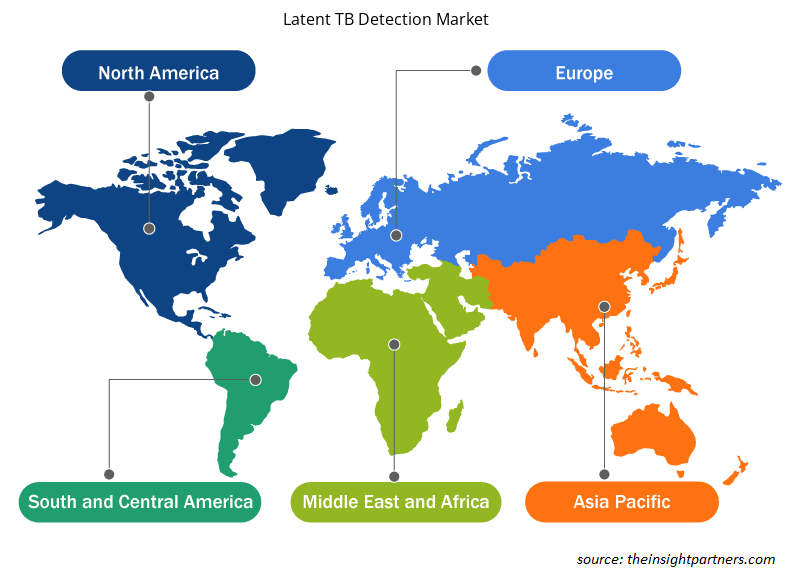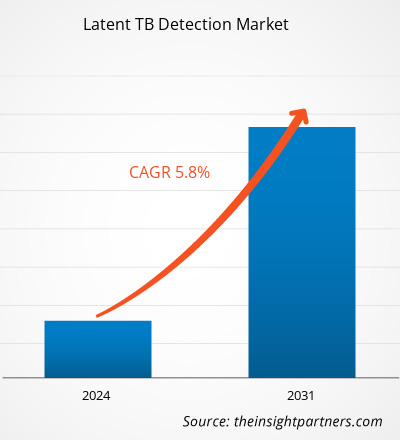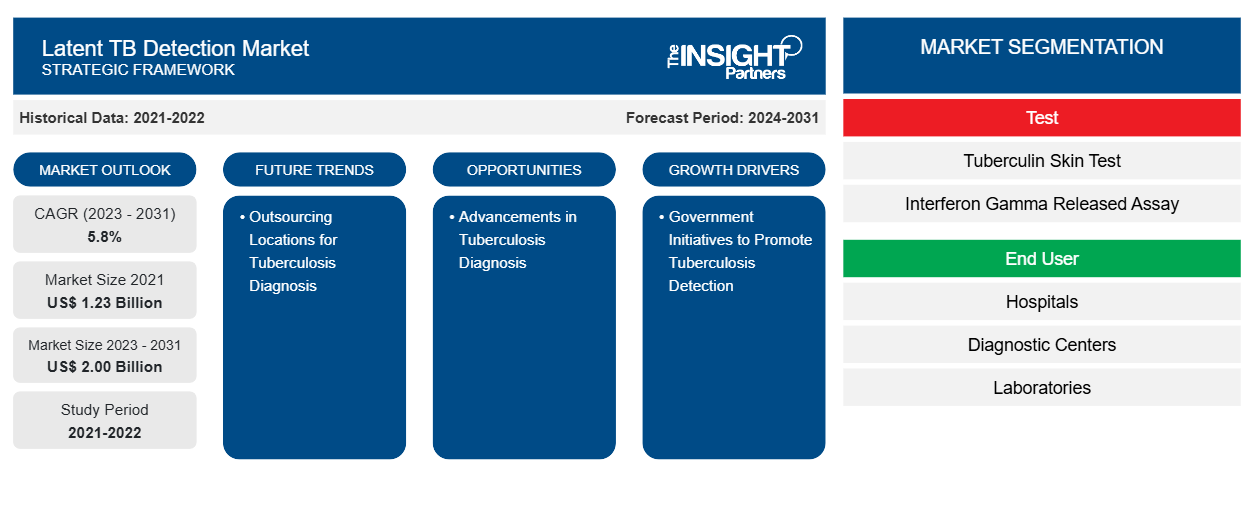Se estimó que el tamaño del mercado de detección de tuberculosis latente sería de 1.230 millones de dólares en 2021 y de XX mil millones de dólares en 2023, y se espera que alcance los 2.000 millones de dólares en 2031; se estima que registrará una CAGR del 5,8% en 2023-2031. Las iniciativas gubernamentales para promover la detección de la tuberculosis y los avances en el diagnóstico de la tuberculosis son factores impulsores. La subcontratación de ubicaciones para el diagnóstico de la tuberculosis probablemente seguirá siendo una tendencia clave en el mercado de detección de tuberculosis latente.
Análisis del mercado de detección de tuberculosis latente
En los países de ingresos bajos y medios, donde la prevalencia de la tuberculosis es alta, los servicios de atención sanitaria son inadecuados, el suministro de medicamentos es limitado, los casos están infradiagnosticados y la comunidad no registra casos debido a la falta de información, todo lo cual contribuye a un aumento de los casos de tuberculosis. A nivel mundial, se estima que 10 millones de personas desarrollan tuberculosis y se producen más de un millón de muertes al año. La India representa más del 25% de la carga mundial de tuberculosis, con una incidencia estimada de tuberculosis de 2,77 millones en 2022. Además, según el estudio de campo en Indonesia, la población que reside en zonas rurales tenía información restringida sobre las causas y la transmisión de la tuberculosis, lo que genera un estigma en la comunidad hacia los pacientes con tuberculosis. Por lo tanto, el Ministerio de Salud de Indonesia ha declarado que Indonesia debe estar libre de tuberculosis para 2035. Además, en 2021, el sudeste asiático notificó casi la mitad de los casos de tuberculosis a nivel mundial, notificando 4,82 millones o el 45,4%.
Descripción general del mercado de detección de tuberculosis latente
La región de Asia y el Pacífico es el mercado de mayor crecimiento para la detección de tuberculosis latente. El crecimiento se debe principalmente a la creciente prevalencia de la tuberculosis, el aumento de las iniciativas gubernamentales para eliminar la infección por tuberculosis y la adopción de productos de diagnóstico avanzados. Los nuevos kits de prueba de tuberculosis latente , IGRA , proporcionan resultados más precisos que las pruebas cutáneas de tuberculina. El país ha puesto en marcha el Proyecto de Control de Enfermedades Infecciosas y Endémicas de China ( IEDC ) para controlar la infección de tuberculosis. El proyecto IEDC logró un enorme éxito. Como resultado, entre 1990 y 2000, el número de personas con tuberculosis disminuyó en un 36,1%. Sin embargo, a pesar de los logros del proyecto IEDC , todavía había problemas con el programa de control de la tuberculosis en China.
Personalice este informe según sus necesidades
Obtendrá personalización en cualquier informe, sin cargo, incluidas partes de este informe o análisis a nivel de país, paquete de datos de Excel, así como también grandes ofertas y descuentos para empresas emergentes y universidades.
- Obtenga las principales tendencias clave del mercado de este informe.Esta muestra GRATUITA incluirá análisis de datos, desde tendencias del mercado hasta estimaciones y pronósticos.
Factores impulsores y oportunidades del mercado de detección de tuberculosis latente
Iniciativas gubernamentales para promover la detección de la tuberculosis
La evidencia de varias fuentes, como la Organización Mundial de la Salud (OMS) y las Naciones Unidas (ONU), muestra que países como India e Indonesia en Asia Pacífico están altamente poblados por pacientes con tuberculosis. Por lo tanto, los organismos gubernamentales de estos países están adoptando ciertos esquemas e iniciativas para contener la enfermedad. Por ejemplo, el Plan Estratégico Nacional Indio ( NSP ), que tiene como objetivo eliminar la tuberculosis, se estableció de 2017 a 2025; instituye varios grupos de apoyo a pacientes, medidas de protección, pruebas de diagnóstico de tuberculosis gratuitas y tratamiento para los indios. Además, en mayo de 2019, los Centros para el Control y la Prevención de Enfermedades (CDC) y la Asociación Nacional de Controladores de Tuberculosis ( NTCA ) publicaron recomendaciones actualizadas sobre la frecuencia de detección, pruebas y tratamiento de tuberculosis para el personal sanitario.
Avances en el diagnóstico de la tuberculosis: una oportunidad
Los fabricantes e investigadores trabajan constantemente para encontrar soluciones nuevas y viables basadas en tecnologías potentes para diagnosticar la tuberculosis con precisión. Por ejemplo, en julio de 2020, Cepheid, Inc. y The Foundation for Innovative New Diagnostics (FIND) crearon una nueva prueba de detección de tuberculosis resistente a los medicamentos que proporciona resultados en 90 minutos. Además, la accesibilidad de los diagnósticos basados en sangre en los ensayos de liberación de interferón gamma ( IGRA ) ha aliviado a los médicos al ofrecer resultados de pruebas confiables para detectar la infección de tuberculosis latente con alta especificidad y sensibilidad. Los nuevos kits de prueba de tuberculosis latente, los ensayos de liberación de interferón gamma ( IGRA ), ofrecen resultados más precisos que la prueba cutánea de la tuberculina, que tiene un siglo de antigüedad.
La adopción del diagnóstico de detección de tuberculosis latente ha aumentado significativamente en varios países de América del Norte, Europa y Asia.
Análisis de segmentación del informe de mercado de detección de tuberculosis latente
Los segmentos clave que contribuyeron a la derivación del análisis del mercado de detección de tuberculosis latente son el tipo de producto, la portabilidad, el tipo de tratamiento, la aplicación y el usuario final.
- Según la prueba, el mercado de detección de tuberculosis latente se segmenta en la prueba cutánea de la tuberculina (TST) y el ensayo gamma relacionado con el interferón (IGRA). El segmento del ensayo gamma relacionado con el interferón (IGRA) tuvo la mayor participación del mercado en 2023. Además, se estima que el segmento similar registrará la CAGR más alta del mercado durante el período de pronóstico.
- Según los usuarios finales, el mercado de detección de tuberculosis latente se segmenta en hospitales, centros de diagnóstico, laboratorios y otros. El segmento de hospitales tuvo la mayor participación del mercado en 2023. Además, se estima que el mismo segmento registrará la CAGR más alta del mercado durante el período de pronóstico.
Análisis de la cuota de mercado de detección de tuberculosis latente por geografía
El alcance geográfico del informe de mercado de detección de tuberculosis latente se divide principalmente en cinco regiones: América del Norte, Asia Pacífico, Europa, Medio Oriente y África, y América del Sur / América del Sur y Central.
Se prevé que la región de Asia Pacífico crezca con la CAGR más alta en los próximos años en el mercado de detección de tuberculosis latente. El crecimiento en Asia Pacífico se caracteriza por el aumento de los casos de tuberculosis y el aumento de las iniciativas gubernamentales. Según la estimación de la Organización Mundial de la Salud, una cuarta parte de la población mundial está enferma de Mycobacterium tuberculosis, y entre el 5 y el 10 por ciento de los infectados desarrollarán tuberculosis activa. De ellos, la India tiene el 27% de los pacientes de tuberculosis a nivel mundial. Por lo tanto, se están llevando a cabo iniciativas. Por ejemplo, el Programa Nacional de Eliminación de la Tuberculosis incluyó la prueba Cy-TB en la plataforma Ni-kshay. Esto marca un avance en el control de la tuberculosis del país.
Perspectivas regionales del mercado de detección de tuberculosis latente
Los analistas de Insight Partners explicaron en detalle las tendencias regionales y los factores que influyen en el mercado de detección de tuberculosis latente durante el período de pronóstico. Esta sección también analiza los segmentos y la geografía del mercado de detección de tuberculosis latente en América del Norte, Europa, Asia Pacífico, Oriente Medio y África, y América del Sur y Central.

- Obtenga datos regionales específicos para el mercado de detección de tuberculosis latente
Alcance del informe de mercado sobre detección de tuberculosis latente
| Atributo del informe | Detalles |
|---|---|
| Tamaño del mercado en 2021 | 1.230 millones de dólares estadounidenses |
| Tamaño del mercado en 2031 | US$ 2.000 millones |
| CAGR global (2023 - 2031) | 5,8% |
| Datos históricos | 2021-2022 |
| Período de pronóstico | 2024-2031 |
| Segmentos cubiertos | Por prueba
|
| Regiones y países cubiertos | América del norte
|
| Líderes del mercado y perfiles de empresas clave |
|
Densidad de actores del mercado de detección de tuberculosis latente: comprensión de su impacto en la dinámica empresarial
El mercado de detección de tuberculosis latente está creciendo rápidamente, impulsado por la creciente demanda de los usuarios finales debido a factores como la evolución de las preferencias de los consumidores, los avances tecnológicos y una mayor conciencia de los beneficios del producto. A medida que aumenta la demanda, las empresas amplían sus ofertas, innovan para satisfacer las necesidades de los consumidores y aprovechan las tendencias emergentes, lo que impulsa aún más el crecimiento del mercado.
La densidad de actores del mercado se refiere a la distribución de las empresas o firmas que operan dentro de un mercado o industria en particular. Indica cuántos competidores (actores del mercado) están presentes en un espacio de mercado determinado en relación con su tamaño o valor total de mercado.
Las principales empresas que operan en el mercado de detección de tuberculosis latente son:
- QIAGEN
- BioMeriux SA
- F. Hoffmann La-Roche Ltd.
- BD
- Compañía: ARKRAY, Inc.
- Abad
Descargo de responsabilidad : Las empresas enumeradas anteriormente no están clasificadas en ningún orden particular.

- Obtenga una descripción general de los principales actores clave del mercado de detección de tuberculosis latente
Noticias y desarrollos recientes del mercado de detección de tuberculosis latente
El mercado de detección de tuberculosis latente se evalúa mediante la recopilación de datos cualitativos y cuantitativos de investigaciones primarias y secundarias, que incluyen publicaciones corporativas importantes, datos de asociaciones y bases de datos. A continuación, se incluye una lista de los avances en el mercado de detección de tuberculosis latente:
- Serum Institute of India (SII) y Mylab Discovery Solutions lanzaron una prueba cutánea en el punto de atención para detectar infecciones de tuberculosis latente (LTBI) a un costo que, según afirman las empresas, es entre un 50 y un 70 por ciento más bajo que el de las pruebas comparables disponibles. A través de varias intervenciones, esta asociación trabaja en el diagnóstico, el tratamiento y la prevención de la tuberculosis. (Fuente: Serum Institute of India (SII)/Comunicado de prensa, octubre de 2023)
- Mylab lanza un kit para detectar la tuberculosis y la variante resistente a múltiples fármacos en una sola prueba. El kit se ha denominado PathoDetect MTB RIF and INH drug resistance kit. Este kit basado en RT-PCR para una detección precisa se utilizará con los sistemas de dispositivos Mylab Compact, que permitirán la realización de pruebas automatizadas de múltiples muestras en dos horas. (Fuente: Reveal Lasers, nota de prensa, octubre de 2023)
Informe de mercado sobre detección de tuberculosis latente: cobertura y resultados
El informe “Tamaño y pronóstico del mercado de detección de tuberculosis latente (2021-2031)” proporciona un análisis detallado del mercado que cubre las siguientes áreas:
- Tamaño del mercado y pronóstico a nivel global, regional y nacional para todos los segmentos clave del mercado cubiertos bajo el alcance
- Dinámica del mercado, como impulsores, restricciones y oportunidades clave
- Principales tendencias futuras
- Análisis detallado de las cinco fuerzas de Porter y PEST y FODA
- Análisis del mercado global y regional que cubre las tendencias clave del mercado, los principales actores, las regulaciones y los desarrollos recientes del mercado.
- Análisis del panorama de la industria y de la competencia que abarca la concentración del mercado, el análisis de mapas de calor, los actores destacados y los desarrollos recientes
- Perfiles detallados de empresas
- Análisis histórico (2 años), año base, pronóstico (7 años) con CAGR
- Análisis PEST y FODA
- Tamaño del mercado, valor/volumen: global, regional y nacional
- Industria y panorama competitivo
- Conjunto de datos de Excel
Informes recientes
Testimonios
Razón para comprar
- Toma de decisiones informada
- Comprensión de la dinámica del mercado
- Análisis competitivo
- Información sobre clientes
- Pronósticos del mercado
- Mitigación de riesgos
- Planificación estratégica
- Justificación de la inversión
- Identificación de mercados emergentes
- Mejora de las estrategias de marketing
- Impulso de la eficiencia operativa
- Alineación con las tendencias regulatorias





















 Obtenga una muestra gratuita para - Mercado de detección de tuberculosis latente
Obtenga una muestra gratuita para - Mercado de detección de tuberculosis latente